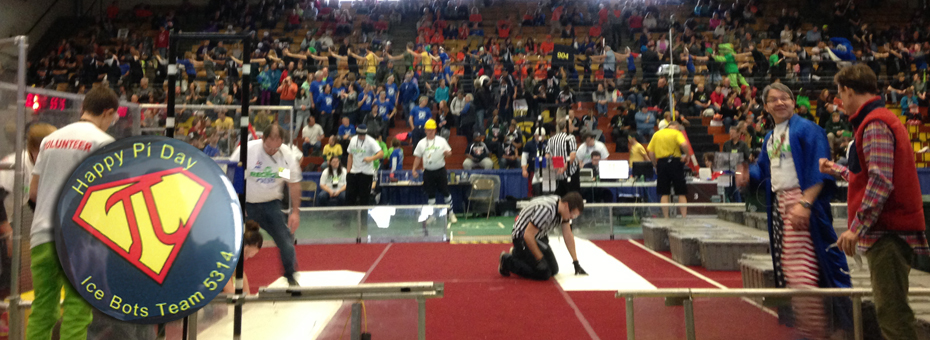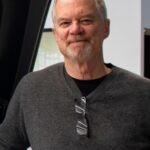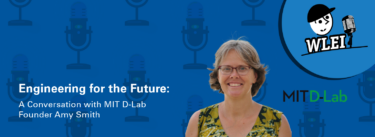To mark the start of Engineers Week, which begins today and runs through Saturday, Feb. 23, we’re re-posting the story “Pi-Day, Robots, and the Joy of Making Things” by a self-described “geek couple,” Jim and Mary Morgan.
Jim is a former global engineering director at Ford whose latest book is Designing the Future about a fundamentally different – and much better – way to develop new products and services. Mary spent 30 years at GM where she was an engineer and then a manager responsible for industrial engineering operations as well as implementing lean manufacturing systems in several powertrain plants for current and new model programs.
Their fun and reflective account about what they saw and heard at a local Pi Day competition for students supports the week’s goal of celebrating engineers’ contributions to society while bringing engineering to life for educators, parents, and kids, especially girls. Founded by the National Society of Professional Engineers in 1951, Engineers Week celebrates how engineers make a difference in the world by bringing engineering to life for educators, parents, and kids, especially girls.
Struck by the passion and joy of the young product developers in the competition, the Morgans concluded that the mood was not only due to the presence of “youthful exuberance” but also what wasn’t present. “They are not focused on building individual careers, fighting for office locations, or titles. No HR policies to impede or eliminate the collaboration and teamwork that underlie high performance,” the Morgans observed. -Ed.
We entered to the sounds of raucous cheering, blaring music, crashing, whirring motors, and flashing lights … obviously, we were spending Pi Day like any self-respecting geek couple, at the district robotics championship! And what an incredible experience it was.
First Robotics was created by entrepreneur, inventor, and iconoclast, Dean Kamen (who is famous for inventing the Segway, iBot mobility wheelchair, and whose company, Deka, has created water purification systems and other solar-powered technology). Its mission is “to transform our culture by creating a world where science and technology are celebrated and where young people dream of becoming science and technology leaders.” This is critically important work!
The event also provides a crucial training ground for future developers by helping them develop fundamental technical skills and experience the profound value of teamwork. It provides junior developers with hands-on experience in understanding and creating new value, rapid and intense learning, design and process effectiveness, and the power of collaboration. People are the beating heart of an LPPD system and these events are a rich environment for growing the next generation of lean developers who will change the world.
We were most struck by the unbridled passion and joy. The kind of joy Rich Sheridan from Menlo Innovations talks about – the joy we have seen lean developers experience in creating great products. The joy of being part of a team and working together to create new value from knowledge, the joy of accomplishment earned through hard work. And, not for the first time, we wondered why that joy is not present in more companies and product development teams. Just like PD organizations, these kids had deadlines, sponsors, rules to abide by, very challenging tasks, and tough competition. But, instead of complaining by the coffee pot, there was conga dancing through the stands, clapping, cheering, and urging each other on. How did they get to that point?
Youthful exuberance aside, the explanation we think at least in part is what’s not there. They are not focused on building individual careers, fighting for office locations, or titles. No HR policies to impede or eliminate the collaboration and teamwork that underlie high performance. There is no one demeaning people’s contributions – everyone from the robot drivers, to loaders, to the pool noodle chuckers mattered equally. And there is no joy sucking fear created by self-serving tyrants masquerading as managers. Instead, knowledgeable leaders and advisors provide guidance, course correct, and enthusiastically cheer the team on. This isn’t typical of what you see in most organizations and it’s hugely different than what most people learn and teach about management.
In the end, both the contest winners and losers were chock full of ideas to improve their next generation bots and literally couldn’t wait to get started on the next product. Now this is the way product development is supposed to be.
As the music quieted and cheers morphed into directing voices, closing thuds and dolly wheel squeaks of the incredibly choreographed, cross-team cleanup dance, we reflected on what we experienced and the meaning of Pi. Pi is a mathematical constant, the ratio of a circle’s circumference to its diameter (=C/d). But like most mathematical symbols, while it is incredibly useful, it can only approximate reality. We think the same can be said for our work on lean product and process development (LPPD). While we can share experiences, methods, and tools across our larger field of practice, it is impossible to capture the sheer joy of participating in a truly great product development team experience without doing it.
Pi is a symbol that is easily recognized and fun to celebrate once a year when it falls on its calendar equivalent of 3/14. Wouldn’t it be wonderful if a company could be recognized as a symbol of LPPD and celebrated for its existence, at least once per year as well?
So get out there… and start your own conga line!
What to do next …
- Experience the passion and joy of product development teams that create not only “insanely great” products and services but also better futures for customers, employees, and stakeholders. Read Designing the Future.
- Read the Lean Post by Katrina Appell, PhD, marking “Introduce a Girl to Engineering Day.”






